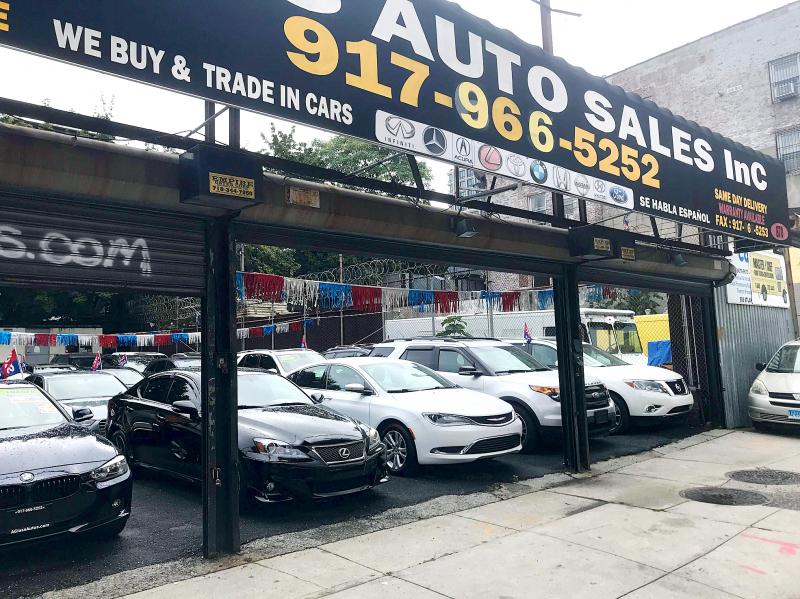Even before the COVID-19 pandemic, Laura Ratliff hated car shopping.
She was hunting for a well-worn, yet dependable, Toyota sports utility vehicle (SUV), but the options did not much impress her. When she got to a certain point with a model or two, they failed inspections with her mechanic. It did not help that the dealers she met fit the stereotype — unctuous and inspiring zero trust. She peeked at some listings on Craigslist, too, but those sellers were sketchier still.
By May, as the Brooklyn, New York-resident found herself in the epicenter of the COVID-19 outbreak in the US, she gave up the search. As a travel writer, Ratliff was often on the go, but for the time being, staying put seemed the best option.

Photo: AFP
Then she noticed a post on Instagram from a fellow travel writer in Denver, Colorado, touting new and used cars from Carvana Corp, an online-only auto dealer. After about 20 minutes of Web comparison-shopping, Ratliff bought a 2011 Volkswagen Tiguan with 136,000 kilometers on it. Within two weeks, Carvana shipped the vehicle from Georgia to Philadelphia.
She showed up in an Uber, plunked a palm-sized coin into the company’s massive vending machine, an elaborate marketing toy, and watched the SUV descend the glass-paneled parking garage like a 1,500kg bag of Doritos.
“This is the first car I bought as an adult, and something about the Carvana experience made me feel more in control and safer, if that makes sense,” Ratliff said. “Basically, I just looked at the odometer and drove off.”
The pandemic has accelerated consumers’ shift from analog to digital when it comes to car shopping. Auto factories ground to a halt this spring just as commuters closed their ride-hailing apps and abandoned public transportation.
Used vehicles quickly became the only fully functioning auto market, yet millions of consumers were leery — even more so than usual — of going to an auto dealership.
It was a set of remarkable, end-times conditions that Ernest Garcia III could not have imagined seven years ago when he started Carvana in a bid to digitally disrupt more than a century of four-wheel commerce.
His business suddenly became one of the best-positioned auto dealers in the US, along with a smattering of traditional dealers who quickly ramped up online sales in the weeks after the first waves of the pandemic. Demand boomed and heading into the summer, inventory across the industry was squeezed.
Thanks to the COVID-19 economy, Carvana, as well as rival start-ups Shift Technologies Inc and Vroom Inc, are seeing growth rates their initial public offering bankers could only have dreamed of.
The trio are focused almost exclusively on used vehicles, with no-haggle pricing and no-questions-asked return policies, but also compete with new-car salespeople, used-car lots and peer-to-peer platforms such as Craigslist and Facebook Inc’s Marketplace.
“Things that were going to take five years to happen took place in five months,” Shift chief executive officer George Arison said.
Last year, about 1 percent of the 40 million used vehicles that changed hands in the US were bought online. Carvana, Shift and Vroom collectively sold 125,411 vehicles at retail in the first half of this year, a 36 percent increase from the same period a year earlier.
Meanwhile, sales of new vehicles cratered and used-auto sales at brick-and-mortar franchises declined 2.7 percent, according to Edmunds.com.
Carvana is selling about one-quarter as many vehicles as CarMax Inc, the largest used-vehicle dealer in the US.
Garcia said he sees a path to moving 10 times as many vehicles in the next few years.
After hitting a low point in March, Carvana’s shares have risen almost sevenfold, spiking when the company late last month updated its full-year forecast.
“The momentum of habit is what makes change occur at the rate that it does,” Garcia said. “There’s never been a period of time in my life when more habits were altered so drastically.”
In the past few months, as lots have reopened for business, the pace of auto e-commerce has only increased, signaling a more fundamental change in the way Americans buy cars.
Gone are the days when people needed to lay eyes on a vehicle. With online videos and a cottage industry of semiprofessional auto critics, it is possible to get a really good look at a model via smartphone.
Precision engineering and gains in manufacturing technology have made vehicles remarkably reliable — just scan J.D. Power’s annual reliability report for reassurance. And most sales, even used vehicles, are backstopped by gracious warranty programs.
For the skeptics, Shift still offers test drives, and Carvana and Vroom have seven-day return periods, as well as robust warranties. Carvana also offers a 100-day “worry-free” guarantee to repair any major problems.
While the momentum in the digital auto market is not particularly mysterious, it did require a catalyst.
The new platforms for selling vehicles were designed to improve what is widely seen as a painful process.
Auto dealerships do not make the majority of their money on an inflated window sticker. Rather, it is an array of more subtle upcharges and fees, from warranty plans to finance referrals.
The average US dealership sells about 37 vehicles per week, according to the North American Dealers Association. On a new car or truck they make a gross profit of about US$2,010. About one-quarter of a dealer’s profit comes from new vehicles, while slightly more comes from used vehicles. The rest — roughly half — comes from fees tied to service, parts, warranties and financing.
“The traditional used-car dealership offers an inferior service,” Vroom chief executive officer Paul Hennessy said. “COVID hasn’t made our business successful, it has made it more successful.”

GROWING OWINGS: While Luxembourg and China swapped the top three spots, the US continued to be the largest exposure for Taiwan for the 41st consecutive quarter The US remained the largest debtor nation to Taiwan’s banking sector for the 41st consecutive quarter at the end of September, after local banks’ exposure to the US market rose more than 2 percent from three months earlier, the central bank said. Exposure to the US increased to US$198.896 billion, up US$4.026 billion, or 2.07 percent, from US$194.87 billion in the previous quarter, data released by the central bank showed on Friday. Of the increase, about US$1.4 billion came from banks’ investments in securitized products and interbank loans in the US, while another US$2.6 billion stemmed from trust assets, including mutual funds,

Micron Memory Taiwan Co (台灣美光), a subsidiary of US memorychip maker Micron Technology Inc, has been granted a NT$4.7 billion (US$149.5 million) subsidy under the Ministry of Economic Affairs A+ Corporate Innovation and R&D Enhancement program, the ministry said yesterday. The US memorychip maker’s program aims to back the development of high-performance and high-bandwidth memory chips with a total budget of NT$11.75 billion, the ministry said. Aside from the government funding, Micron is to inject the remaining investment of NT$7.06 billion as the company applied to participate the government’s Global Innovation Partnership Program to deepen technology cooperation, a ministry official told the

Taiwan Semiconductor Manufacturing Co (TSMC, 台積電), the world’s leading advanced chipmaker, officially began volume production of its 2-nanometer chips in the fourth quarter of this year, according to a recent update on the company’s Web site. The low-key announcement confirms that TSMC, the go-to chipmaker for artificial intelligence (AI) hardware providers Nvidia Corp and iPhone maker Apple Inc, met its original roadmap for the next-generation technology. Production is currently centered at Fab 22 in Kaohsiung, utilizing the company’s first-generation nanosheet transistor technology. The new architecture achieves “full-node strides in performance and power consumption,” TSMC said. The company described the 2nm process as

JOINT EFFORTS: MediaTek would partner with Denso to develop custom chips to support the car-part specialist company’s driver-assist systems in an expanding market MediaTek Inc (聯發科), the world’s largest mobile phone chip designer, yesterday said it is working closely with Japan’s Denso Corp to build a custom automotive system-on-chip (SoC) solution tailored for advanced driver-assistance systems and cockpit systems, adding another customer to its new application-specific IC (ASIC) business. This effort merges Denso’s automotive-grade safety expertise and deep vehicle integration with MediaTek’s technologies cultivated through the development of Media- Tek’s Dimensity AX, leveraging efficient, high-performance SoCs and artificial intelligence (AI) capabilities to offer a scalable, production-ready platform for next-generation driver assistance, the company said in a statement yesterday. “Through this collaboration, we are bringing two